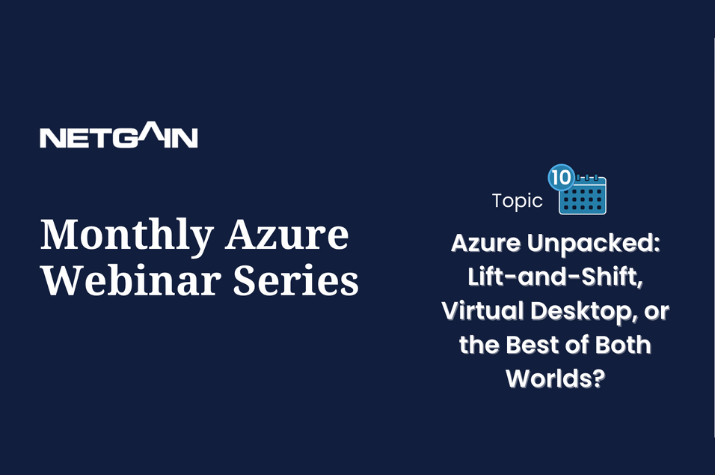Lift-and-Shift, Virtual Desktop, or the Best of Both Worlds?
In a recent webinar, Netgain’s VP of Accounting, Kate Krupey and VP of Product, Bill Sorenson discussed the different approaches CPA firms are taking when migrating to Microsoft Azure. They explored the reasons behind this migration, the unique challenges, and the benefits that Azure offers to these firms. This article summarizes the key points from the webinar and sheds light on how CPA firms are embracing Azure for their cloud needs.
Why Azure? Before delving into the various approaches CPA firms are adopting, it’s essential to understand why Azure has become an attractive option. Several compelling reasons were highlighted in the webinar:
- Scalability: Azure offers virtually unlimited scalability, enabling firms to meet the demands of busy seasons by scaling up resources and scaling back when needed. This flexibility is especially crucial for CPA firms engaging in mergers and acquisitions, hiring groups of interns, and managing seasonal workloads.
- Innovation: Azure promotes innovation by allowing firms to create and manage test environments, development environments, and new applications without committing to the long-term costs of physical infrastructure. Microsoft’s ecosystem, from SharePoint, Office, and the Power Platform to tiered storage, georedundant backup solutions and turnkey disaster recovery is all hosted in Azure, making it the perfect platform for CPA firms to leverage in future proofing their innovation plans.
- Always Current Hardware: Microsoft invests heavily in the hardware that supports Azure and offers the same “always updated” subscription model Firms have adopted with SaaS (Software as a Service) applications including Office products. Hardware refresh cycles are a thing of the past with Azure. Firms are always on the latest hardware which supports their ever-evolving software landscape.
- Cost Efficiency: Azure’s pay-as-you-go model allows firms to pay only for the resources they use. It eliminates the need for expensive hardware purchases, leading to cost savings and improved resource allocation.
Three Primary Approaches CPA firms Use to Migrate to Azure
- Deploy Azure Virtual Desktop (AVD) First Approach:
In this approach, firms prioritize deploying Azure Virtual Desktops, typically for outsourced or offshore teams. It provides secure access to applications and data for remote teams. AVD instances are placed close to the end-users, ensuring optimal performance. This approach is useful for firms that are not ready to transition all their resources to Azure but want to start with desktops. - Lift-and-Shift:
Firms can move their servers to Azure in the “lift and shift” method. In this case, Firms move applications and data to Azure before supplying end users with AVD (Azure Hosted Desktops). This method is favored by firms who need more time to work through selling the concept of a hosted desktop to key stakeholders. By moving the “back end” to Azure first, firms are able to introduce AVD slowly and by demonstrating the actual end user experience. It is also a great method for firms who are under timeline pressures of contracts that are ending on data centers or have key infrastructure at end of life. - A Hybrid Approach:
Some firms choose to transition both the front-end (AVD) and back-end (applications and data) to Azure simultaneously. This approach is often preferred by firms already using hosted desktops or those who have successfully sold the change to hosted desktops internally.
Considerations for Your Azure Approach
When deciding on the right approach for your firm, consider the following factors:
- Cultural Change: Evaluate how receptive your firm is to change, especially when introducing hosted desktops or new workflows.
- Offshore Workforce: Assess the extent to which your firm relies on an offshore team, as this can influence your approach.
- Hardware and Contracts: Consider your existing hardware’s condition and the status of data center contracts, as these factors may drive the decision to migrate.
- Applications: Determine how critical applications are used within your firm, as this can impact the speed and efficiency of your migration.
- Cost and Performance Optimization: Keep in mind that Azure can be costly if not optimized properly. Seeking professional guidance can help identify and rectify any cost overruns.
The webinar highlighted the diverse approaches CPA firms are taking to embrace Microsoft Azure, emphasizing the numerous advantages Azure offers. Whether firms opt for a gradual transition, a complete overhaul, or a hybrid approach, the key is to make a well-informed decision based on their unique needs and circumstances. Azure continues to empower CPA firms with scalability, innovation, and cost savings, making it a compelling choice for their cloud migration journey.
Get access to the full webinar recording below to learn more about how you can take your firm into the future by adopting Azure.
Upcoming Webinar
- November 28 – Best Practices in Supporting Your Off-shore Workforce in Azure?
